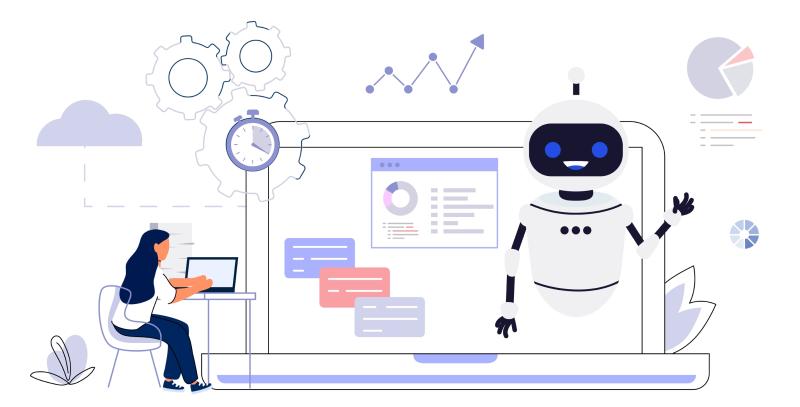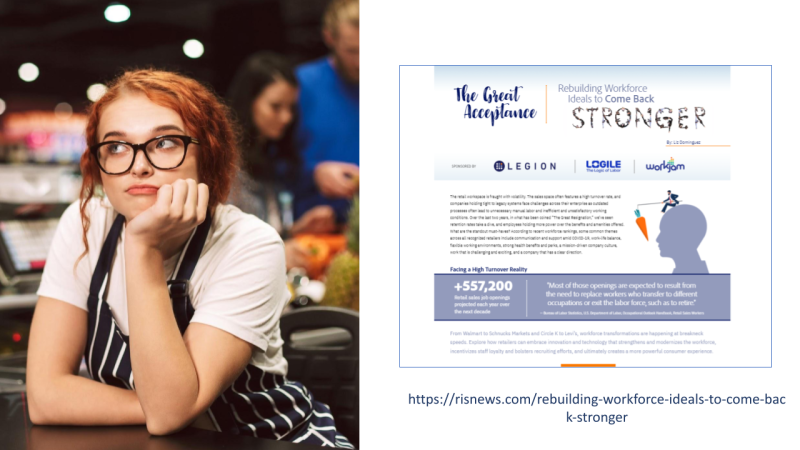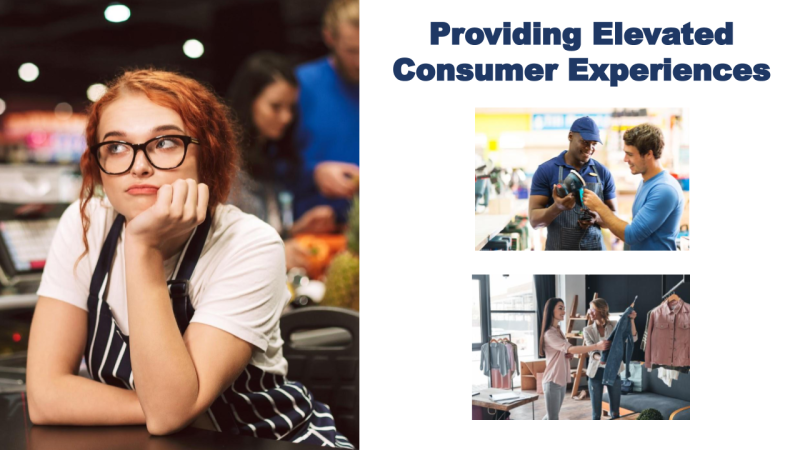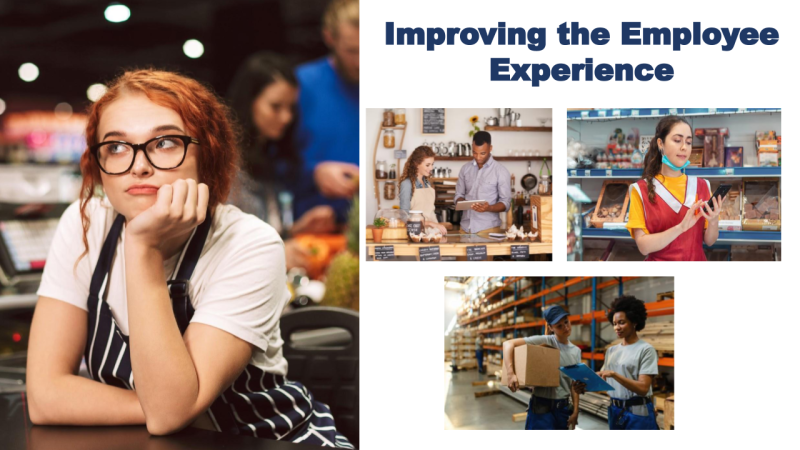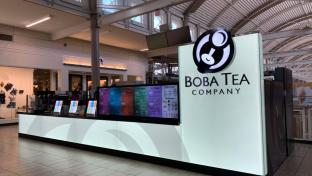How Walmart, Levi’s, and Nike Are Thriving Amid the Great Resignation
We are continuing to navigate a volatile, COVID environment, and the last two years have led to significant lifestyle changes. As part of that shift, retailers have continued to focus on efforts to attract and retain workers as job and workplace preferences drastically changed during that time.
Employees are now taking the reins, often demanding a gig-like environment that includes improved work-life balance, higher wages, better benefits, and more agency. In response, retailers are leveraging new tech to help recruit, train, and better communicate with employees, as well as implement strategies that eventually trickle down to the end customer, resulting in elevated consumer experiences.
Retailers such as Walmart, Target, Nike, Levi’s, and more are transforming the modern workplace, embracing automation and technology like AI and ML. Using the backdrop of RIS’ latest research, learn how to apply these strategies to your own business to compete during this era of workplace innovation.
In this edited version of the webinar transcript, RIS News’ Jamie Goodman and Liz Dominguez share how retailers can create a robust hiring strategy that takes DEI into consideration, minimizes time-consuming tasks, improves employee and customer experiences, and helps the company stand out by building a reputation of loyalty that boosts recruiting and retention efforts.
Jamie Goodman: Welcome to the “Standing Out in the Crowd: How to Develop and Preserve the Best Workforce” webinar, which is hosted by RIS and presented in partnership with Legion. I am Jamie Goodman, editor-in-chief of RIS News.
As we all know, there's stiff competition right now to attract and retain workers in the retail industry, both on the front lines and at the corporate level. The more retailers struggle, the more employees hold power over the benefits and perks that they're increasingly demanding. How can retailers stand out in the crowd? What technologies can help retailers recruit, train, and communicate with employees as well as assist customer facing employees to provide a superior experience that we know builds shopper loyalty.
Today, we'll cover topics around creating a robust hiring strategy that takes diversity, equity, and inclusion into consideration; minimizing time consuming tasks; improving employee customer experiences; and ultimately helping your company stand out by building a reputation of loyalty that boosts recruiting and retention efforts.
With us today to explore how technology is helping retailers both develop and preserve the best possible workforce are Traci Chernoff of Legion Technologies and Liz Dominguez of RIS News and Consumer Goods Technology. Traci and Liz, thank you so much for joining us. Please take a moment to introduce yourselves.
Traci Chernoff: I am Traci Chernoff, the director of employee engagement at Legion Technologies. I spent my entire HR career in retail before joining Legion, and was actually on the customer side of Legion before joining and hopping the fence so to speak. I spent about a decade between big box retailers such as Target and luxury fashion retailers like SMCP, the brands Sandro and Maje. I also have a podcast called “Bringing the Human Back to Human Resources.”
It goes without saying that I love talking about HR and it is everything that I do. I love that I'm able to be here today with Legion, with all of my retail experience, talking about these topics.
Liz Dominguez: I'm the managing editor for both the RIS and CGT brands at EnsembleIQ. I've spent my career covering a wide range of topics in the B2B trade media space, and I'm really excited to dig into the research we just published on workforce management.
Goodman: Great, thank you both so much for joining us. Many of the topics that will be discussed today were covered in RIS' recently released special report, “The Great Acceptance: Rebuilding Workforce Ideals to Come Back Stronger.” We're going to explore a number of key topics and themes from the report here today, but we encourage everyone interested in a deeper dive of the topics to go and check out the report.
Retailers have repeatedly been challenged over the past few years, whether it's COVID restrictions, supply chain woes, or rising inflation. Retailers big and small keep coming up against obstacles and all of the while consumer preferences have been changing almost daily. One of the biggest ongoing obstacles, which doesn't look like it's going to subside anytime soon, is the need to attract and retain talent.
Companies are overhauling recruiting strategies, focusing on building out areas surrounding digital innovation, and hiring talent that can go the distance. Recognition that change is needed has set in across the retail industry. During our recent Analytics Unite Summit, the CIO of Lowe's put it best when she said, "Every morning when you wake up and think about talent, you should tell yourself only one thing. Today is the easiest day to attract talent because tomorrow it's going to be more difficult."
At this point, I'd like to discuss how today is the easiest day to attract talent and what retailers can do to deal with the difficulties of tomorrow. Traci, there's stiff competition to attract and retain workers in the industry — both on the front lines and at the corporate level — how would you advise retailers to stand out in a crowd?
Chernoff: The first step is to always acknowledge that no one is immune to these challenges. We all have an opportunity to not only be competitive with one another, but also listen to what the employee demands are. Retailers, whether they're legacy retailers or maybe they have a reputation for being employee focused, often think they can take the backseat a bit because this doesn't really apply to them.
However, we've seen throughout the last few months, especially with labor relations taking the helm, that no one is exempt from meeting the employee in the middle and understanding what those demands are. The first step is to listen and go into a conversation willing to take the feedback and actually action it.
It doesn't make any sense to ask for feedback and not do anything with it. The hardest part is to get that information. The second hardest part is to actually action it. Once you have that feedback — whether employees are saying they want to have clarity on their growth, want to feel more appreciated, or want better pay, etc. — taking that, strategizing an action plan to answer those questions, and solving some of those challenges will allow for a transparent, clear approach that employees can walk away feeling good about.
Goodman: That could be true for any industry, too, not just retail. Liz, what is needed for retailers to create a robust hiring strategy that also takes DEI into consideration?
Dominguez: I’ll echo a bit of what Traci was speaking to in terms of having that feedback. First and foremost, have a strategy in place. Who are you going after? How are you going to do that? Retailers need to break down the recruiting by category and goals, and be thoughtful about how they're going to attract new talent.
For example, Albertson's is being more intentional about charting growth for employees before they even hire for the role. Many companies are having large scale hiring events to knock out bulk hiring with one promotional cycle. These can be helpful to fill staffing gaps in specific areas, whether it be technology, sales, or supply chain. Kroger recently held a hiring blitz where it looked to fill 23,000 roles.
There's another element that's starting to play a bigger role in recruiting and retention today, which is diversity, equity, and inclusion efforts. Job seekers are looking for a mission-driven company culture and brands that share those same values. Most of the major retailers are building this into recruiting efforts. Walmart, for example, looks at underrepresented groups such as women, people of color, military community members, formerly incarcerated individuals, and return to work caregivers.
Some brands have taken it a step further. For instance, Walmart, Nike, Under Armor, CVS Health, and others have joined the Data Interest Alliance to make sure that bias is removed from workforce decisions. This impacts everything from recruiting compensation to employee development.
Goodman: It’s a nice step forward. Traci, retail workers expectations have changed as well, and they’re now holding the cards in a lot of ways. What are they expecting when it comes to hiring and pay?
Chernoff: It's very true. The power has shifted, the demand has shifted. What we see, especially at Legion — we published a “2022 State of The Hourly Workforce Survey” — is that employees and managers alike want flexibility. They want almost a gig-like experience while having the stability of a full-time or a part-time commitment.
When we think about the term flexibility, it’s thought of as employees and managers wanting agency over their decisions and their lives, to fully integrate that within their environments and their organization. At Legion, we focus on enabling organizations to do. Meaning, when we say flexibility, it's a matter of being able to say, “this is my availability. These are my preferences.”
It allows them to easily swap shifts with someone without having to go through that middle person like the store manager or team leader, for example. It even allows them to be able to work a few more hours one week or work a few less hours another week. The level of agency we've seen coming out of COVID has taken the lead in terms of what employees want.
The sooner retailers, or employers, can see that this is a matter of finding the ways in which both employers and employees can be happy, that's when you get into the arena of having open dialogue, employees are happy, more engaged, and have that agency over their lives.
It's not so much about work-life balance anymore. It's more about being this whole person. We see this in DE&I as well, but being this whole person coming to work — being balanced within that environment and being balanced outside of work as well.
Goodman: It doesn't have to be done the way it's always been done, and it's not that hard to make the change.
Turning over to talent and recruiting, what attracts retail workers in such a tight labor market? According to recent workforce rankings, we see some common themes across winning retailers, including communication, support amid COVID, work-life balance, flexible working environments, strong health benefits and perks, work that is challenging, and a mission-driven company culture, which we've already mentioned. It's top of mind. Traci, when recruiting employees, what perks will help attract retail workers?
Chernoff: Think of it as: What are the minimum expectations that employees have and what are the added benefits, the perks to your point that they want to see? Those minimum expectations are fair pay, good benefits, and a work-life balance. Coming back to all these things that we mentioned, an environment that encourages development, growth and happiness.
The perks are things that are more progressive than we've seen in the past. Things that, in 2019 or at the start of 2020, were future-looking perks that companies started to talk about, for example, Instant Pay. At Legion, we offer a solution called Instant Pay where employees can work shifts and have access to the wages they've already earned.
That is a true perk because it's not something that companies across the board are offering, but it enables this agency within an employee's life, within their experience that provides the ability to live their lives the way they need to. As an example, think about the hourly employee. Fifty eight percent of eligible, working Americans are hourly employees, earning an income on an hourly basis. If you take a percentage of those individuals who are working part-time or a minimum wage job, they're probably living paycheck to paycheck.
To enable them with a perk, like Instant Pay, gives them flexibility. Rather than being late on a minimum payment for something that has been chasing them for a little while, they can work the hours, take on more shifts because they see what they'll earn, and have access to a certain percentage of that earned wage. Thinking through earned wage access fully, that gives a sense of peace in knowing that the perk is fully dedicated toward their experience.
Instant Pay doesn't do anything for the employer. It is fully investing in what the employee potentially needs. Maybe they don't need it today, but they'll need it tomorrow. I always use that as an example of a perk because it's not something that is a minimum expectation. We should always expect to have those minimum things from employers and perks are what is added on.
Goodman: It separates you from the rest. Liz, can you provide some insight into what's going on in the modern job landscape? What job seekers are prioritizing and how retailers can leverage these as opportunities?
Dominguez: We went with “The Great Acceptance” as the title for our new report because it plays on the great resignation. A flood of people are leaving jobs in search of opportunities that provide more of the benefits that they're looking for. Job seekers' expectations keep growing and retailers need to accept that. Of course, retailers can check all the boxes, but we're finding that there are many trends that should be considered.
Compromise might be necessary. They should anticipate requests like extended PTO or higher salaries. The cards are in job seekers’ hands right now, and there's a lot of competition. If they don't adapt, they'll find themselves lagging in recruitment.
According to Michael C. Bush, the CEO of Great Places to Work, companies are being recognized for making the workplace equitable, safe, and productive. In a quote he said, "Their commitment to genuinely care for their people through trust, inclusion, purpose, and meaningful flexibility for life circumstances goes beyond surface level perks and is a model for the market to follow."
Goodman: Traci, with higher turnover rates in retail, what can retailers do to keep employees engaged and build a reputation of loyalty that's going to boost recruiting and retention efforts?
Chernoff: This is an age-old question. The reality is that so often we are applying the same solutions. We have to elevate these minimum expectations. We have to offer more perks. We have to go above and beyond with appreciation and recognition. All of those remain true, but the challenge is that we can't keep solving the same problem with the same solutions. Part of it is recognizing that there will always be turnover, especially in retail, especially at minimum wage pay rates.
There is a certain expectation that sometimes people see retail as a stepping stone and not necessarily a career path. Sometimes there is an opportunity for retailers to do a better job of communicating all of the career possibilities within retail.
For example, I started as a sales associate when I was in high school and worked in sales for a retailer in college as well. Then, when I got my job at Target as a leader, I moved into the HR realm. I never knew that was a possibility and I loved it. It was the reason I'm here today. If employers can help a sales associate making $15 an hour, see that they could become a chief operations officer one day, that's an incredible opportunity.
Retail is known for changing constantly, never having the same day. Sometimes, especially as businesses scale, things can become more rigid — whether it's HR policies or otherwise — in the ways that people and their careers are treated.
Sometimes businesses say, "Well, you can't even get promoted until a certain amount of time." This is where, if retail can become even more agile and loosen up some of that rigidity, it will allow employees to see a bit more flexibility. Not just feel it, but actually see that an employer is going to go above and beyond when they go above and beyond, or when they're meeting the basic needs of their roles.
It's a very vague response because I'm still looking for that solid answer, but those are two things that we're not necessarily doing every single day and could be a different solution applied to the same problem.
Goodman: Carving out a career path for your employees, at whatever level that they're at, and presenting them with that career path is a perk in itself because that isn't something that every company is doing, especially retail. Even across the board of industries to present a part-time employee, full-time employee, any level of employee with this path throughout — that alone, even if it's flexible and not carved in stone, just presenting it is a perk in itself.
Chernoff: Actually, that reminds me, how often are we hearing (on surveys or within feedback moments) that employees don't feel like their employers are prioritizing internal growth. It's either because they're looking for a specific skill set or a specific amount of experience. But how can retailers flip the script a little bit? How can we enable training moments, coaching and development, and be okay with hiring or promoting someone who may not have the exact experience you're looking for.
Giving them the opportunity to grow into that is worth so much. In all of my retail experience, this was always true, those who were internally promoted had a longer stay within a company than someone who was brought in from the outside.
Goodman: On the technology side, a lot of companies are looking now at how you might have employees right under your nose that are qualified for a position. A lot of bigger companies are starting to tap into identifying this missing skill, and starting a program to teach them so that they can take this next level job. These are simple tricks, but if you turn inward and look at what you already have, it's helpful.
Next we are going to turn to once you have a talented workforce, what can be done to improve employee and customer experiences to create loyalty on both sides of the coin? Workforce modernization impacts more than a company's employees. Happier, better utilized employees impact the customer experience as a whole when employees' roles are made more efficient and associates feel more connected.
There's a widespread impact that's touching the customer experience across channels. With this in mind, what can retailers do to improve customer experiences through their work. Traci, how can flexibility be a benefit to employees and in turn have an impact on the customer experience shoppers are specifically getting inside stores?
Chernoff: The happier the employee, the happier the customer. This is written in stone somewhere that no matter what retailer you walk into, if you have a great experience, it's because that employee is happy. At some level, the employer is doing something to enable their happiness. When we think about providing these elevated consumer experiences that are encouraging this flexibility, what is something that we all like, even internally, when we think about our lives today, what do we want?
We want to work where we want to work. We want to work when we want to work. We want to be autonomous, own our business and have that flexibility, that agency over our lives. An hourly employee, a retail employee is no different — they're just working in a different position than we are.
At Legion, for example, our mission is to turn hourly jobs into good jobs. It's not a blanket statement that's philosophical and existential. If we can make that hourly job a good job, which is a huge mission to embark on, then we are also enabling that employee to make the customer have an incredible experience to enable that customer to have a wonderful experience.
If you can think about a retailer that you've walked into and pretty consistently have a good experience, or a not so good experience, that employee is passionate about what they do. They feel appreciated. They're working the schedules that meet their needs.
This is where, as a workforce management solution, every single day we look at how we can take our scheduling platform or time and attendance platform, and enable employees to have flexibility to enable employers to provide employees flexibility. The sooner a retailer can see that correlation between employee experience and customer experience and then build on it by understanding needs will be met if the needs of the team are met first, then that is where the magic happens.
The final point is that in terms of your teams or anyone you’re leading, you’ll never have to worry about the business, key results, etc. if you’re focused on providing the team and the employees what they need. Whether you're an HR professional, retailer, store manager, or team lead that will always remain true. If the focus is on the audience and what they need to be happy and successful, you'll never have to worry about your results.
Goodman: That is definitely true. Liz, what sort of communication solutions are we using today to engage staff that go above and beyond traditional methods?
Dominguez: We're seeing a lot more two-way communication in the field. Employees are looking for increased visibility into employee performance, and employers want better access to information like company policies as well as a more efficient way to communicate paid time off requests and switch shifts. Many of these tools are app-based, making them simple to use.
We highlighted one retailer in the report who launched a mobile app that provides increased visibility into employee performance. This allows managers to take on a more active role and provide additional support like skill-based training, wherever it's needed. Another brand incorporates technology that allows it to more accurately schedule staff through improved forecasting accuracy to meet consumer needs. Throughout the pandemic, these tools have been especially effective because retailers are able to fill staffing gaps by sharing workers across locations and easily track the information.
Improving communications within the corporate environment can also help support the workforce. For example, Rite Aid unveiled a new headquarters in Philadelphia's Navy Yard District. The 23,000-square foot center features a variety of conference room styles with digital Neat Boards for video conferencing, a digital video studio, and a genius bar to support IT needs — these tools help bridge the gap between the in-office staff and remote corporate workforce. It helps keep the lines of communication open between not only employers and their employees, but also with colleagues and clients.
Goodman: Traci, to Liz’s note, what communications are retailer employees looking for today, and how did these types of technology influence the experience?
Chernoff: At the risk of making a joke, they're looking for any communication. It's definitely on-trend that retailers are often able to communicate to their managers because they have employee email addresses and a bit more of that touchpoint. Again, coming back to the end user, the hourly employee, they're still relying on bulletin boards.
I love that Liz mentioned a mobile app because if we've learned anything from Gen Z, it’s that gone are the days where you have to rely on anything other than your fingertips to get information. You have to have that digital touchpoint at their fingertips. What we see through Legion’s communications tool is that employers, managers, or whoever is in the driver's seat is able to send communication depending on the setup that the organization takes — they can directly communicate with part-time sales associates that only work on the weekends.
It’s a huge enablement tool because, thinking about the hourly employee or your own experience, they’ve always relied on a bulletin board. I relied on huddles or chat-ins from my managers, but not every manager is able to chat-in or have a huddle at the point that an employee starts their shift, and not every leader sees the value in that.
It helps them feel appreciated because, again, an age-old piece of feedback for any retailer has been that things are not transparent — there’s not enough communication, and sometimes we solve these problems with the same solution, sometimes it's never truly solved.
Taking this digital touchpoint, minimizing the friction points for employees, and understanding what that end user needs, then allows that communication to happen.
In my experience, on the retail side, when you have those hourly employees feeling connected this further enables the feeling of being appreciated and being part of the team. It shouldn't be a perk, but it is because most organizations are not prioritizing that type and level of communication.
Goodman: Let’s get deeper into the employee experience. The stakes are high as retailers now have such a competitive hiring environment and the modern employees are looking for higher wages. The unique benefits we've been talking about today — increased flexibility, work-life balance, all the things we've talked about today — overall a better daily work environment.
However, where technology can help it can also be a hindrance to some. It's important to find that balance. Retailers need technologies that are going to be easy enough to learn by every employee who uses them while also finding these solutions that redirect associates to more fulfilling tasks, such as helping shoppers and being on the floor with people more as opposed to doing mindless tasks over and over.
Liz, how are retailers improving the employee experiencing and helping minimize these time consuming tasks that take away from the customer-facing duties?
Dominguez: There's a culture of automation that's taking over. Companies aren't necessarily looking to take away work from the staff, but they are trying to optimize efforts. That might mean cutting out the time intensive tasks, things that are more manual in nature, so they can focus on more dollar productive responsibilities. Particularly, those that ultimately elevate the consumer experience.
One company we highlighted in our special report was Levi's, who is implementing robotic process automation to cut down on manual tasks. So far it's saved them a total of 500 hours of manual labor. They used the merchandise coordinators as an example, they were manually entering more than 4,000 product codes into the company store systems — imagine how long that would take.
By leveraging the efforts of just one bot, it accounts for the efforts of five people, which amounts to nearly 750 hours. Levi's chief financial officer Harmit Singh said, "they're seeing not only an immediate reduction in operational cost, but also an increase in employee satisfaction as staff can focus on higher value activities."
Not included in the report, but worth mentioning, is Amazon. According to a recently reported leaked memo, the company is facing some significant hurdles in workforce management. They're having difficulty hiring, and according to internal research from mid-2021, the company could run out of people to hire in its U.S. warehouses by 2024. Amazon is looking to automation to help fix that problem.
The company recently unveiled the most advanced autonomous mobile robot to date, called Proteus, noting "that historically it's been difficult to safely incorporate robotics in the same physical space as people, but Proteus will change that while remaining smart, safe, and collaborative." This type of robot uses perception and navigation tools to learn its environment. The robot can carry large racks of products with heavier payloads.
Walmart, for example, ties in its reward system with opportunities for consumer engagements. They offer Walmart+ memberships to all full- and part-time employees so that they can not only enjoy the benefits, but also share the experience with consumers.
Last year, Target launched a Debt-Free Education Assistance Program to more than 340,000 frontline associates. Through this, employees can get debt-free assistance for eligible undergraduate degrees and certifications. Ultimately, it's improving the employee experience and showing appreciation by rewarding hard work, implementing technology that makes employees lives easier.
Goodman: Traci, there's plenty of technologies out there to support the workforce, but not all of them are very easy to master. What do retailers need to consider when implementing these tools and making choices on tech that's going to support their employees?
Chernoff: Two words: change management. There has to be a strategy around how you implement new technology or elevate the technology that already exists within an organization. Change management is something that is often overlooked because of this failure to remember who the audience is. If you're rolling something out that is impacting hourly employees, a corporate intern, or someone that you don't have as many touchpoints with, you have to keep them in mind.
The best advice is to bring key stakeholders into the planning process if you're going to be rolling out a project, you're ideating, figuring out what the actual rollout looks like. Once that’s done, bring in or make part of the rollout, people from different states, store types, corporate types, or departments, and have them involved in that process so you can get feedback from your end user, your audience, but also get their buy-in.
Sometimes, you potentially bring in someone who doesn't adapt as quickly to technology. Then, they're also a case study for how quickly this technology can be fully implemented into the organization.
I also have an example from rolling out and incorporating Legion into the retailer I was working for. I use this because it's an example of new technology with a retail population that is notorious for retailers not always being open to change, even though we are constantly changing.
When we signed with Legion, we were bringing them into SMCP. Part of my rollout was focused on the change management piece and bringing in these key stakeholders — specifically store managers in different store types, different volumes, different experience levels, and different levels of that adoption scale — some early adopters and some laggards. In doing that, we also ran a survey to see how many hours they were spending on scheduling and workforce management.
They were spending more than 10 hours at a time on average. We committed to them that by enabling this new technology, bringing Legion to the workforce, we were going to save them time, allowing them to reinvest that time savings back into their businesses by coaching their teams, spending time with their teams, whatever that looked like to them. It enabled them to have a different level of commitment with the technology. It wasn't something they were testing, rather something they were excited about working because they're going to save time. That gets them excited.
By the end of the rollout, they saved more than 60% of their time. They went from 10 hours in workforce management, to spending three hours at a time. That extra seven hours generated an increase in sales revenue by 20% in just one month. When they saw that tangible result, that technology didn't replace anything for them, but enabled them to do more with their time and reinvest in the things that retail managers love, such as coaching, selling, training, etc. That's when the news spread like wildfire.
They told all the managers that were not part of that initial rollout and change management process, saying, "This is amazing, you're going to love it." It enabled the success and adoption of the new technology of bringing Legion to SMCP.
Goodman: I can't tell you how many retail IT execs I've talked to and every single time I ask: what's your biggest challenge? The answer is change management. There's not enough positive stories out there of retailers that can say the change management was great on this project.
Over and over I hear to get your key stakeholders in there, get them in from the beginning, make sure you're managing it up front in the best way possible. There's no better change management than word of mouth.
Traci, looking toward the future, how might these technologies evolve as job seeker expectations change? If you had a crystal ball...
Chernoff: If I had a crystal ball, I'd really be able to make some predictions. Technology will adapt in a couple ways for those of us that are not at the frontline. It will adapt in the way we meet, connect, and work together. Looking at those frontline employees, there will be certain jobs that will be elevated by technology doing the things that are less value add for or that adds value to that person.
Think about something like a fry cook cleaning the top of the stove — that's something they don't get a lot of value out of. This is an arbitrary example, but technology will enable the employee to not have to do that and spend their time doing something else. I'm pulling that out of thin air, but when we talk about technology, we think about these huge solutions or companies, sometimes it's a matter of looking at how technology will grow to enable that employee to do more.
Even at Legion, as we continue to grow, we'll see this movement from other retailers because many have seen the need for workforce management solutions. We've talked about it a few times, but it'll be a movement for retailers to be more automated. Rather than looking at a fry cook needing to clean a stove, we could see the sales associate on the sales floor at Target or another retailer, who just wants to be scheduled within their preferences.
They don't even want to be offered shifts, maybe that's something that is just automated for them. That gives them that gig-like flexibility that they want. It's hard to predict exactly how it will continue to elevate, but if there's anything that's true, it's that we're seeing this continued push from employees to have their demands and expectations met — and companies will. It's going to be too much, too labor intensive to manage that manually. At the very least, retailers and companies in general will need to automate some of those more basic elements of the day-to-day for a manager.
Goodman: It sounds like you feel that employees are looking for real, authentic two-way partnerships from potential employers. The big takeaway from this webinar is that employees just want to be seen. These technologies are helping give you a way to make that happen in a way it hasn't in the past. What do you think, Traci?
Chernoff: I completely agree. This is exactly what I mean when we say real, authentic, two-way partnership — that’s exactly it. Employees don't want to feel like the end result, or the people who are told what to do and where to be; they want to be part of the conversation, they want to be seen.
How does an employer with 50,000 employees do that? Communication. This is a huge way of enabling that because if employees at minimum feel that they're being spoken to directly from the organization, from a leader, someone in the C-suite, it goes a very long way. We can't dilute that need and the importance of that.
Then, thinking about authenticity and realness. I mentioned earlier that employees are coming to work as their whole selves. It's not Traci at work and Traci at home — we are who we are and we have to make room, make space for people to bring all of themselves to work from a DE&I perspective, a psychological safety perspective, and everything in between.
Goodman: Employees want to feel valued, and value means different things to different employees. There's no off-the-rack solution. There's been a lot of discussion around the gig economy and the trends towards this type of employment. How can employers, retailers compete with gig work?
Chernoff: In terms of this gig-like flexibility, retailers and employers need to lean into it. What is so encouraging about someone working for Uber or Postmates is that they can work when they want, they know exactly what they're going to earn when they pick up that order or pick up a shift. What is that? That's transparency, that's earned wage access, that's flexibility.
Retailers aren’t necessarily going to say “ok, you can work when you want,” but retailers can say, “tell me what you want, the type of flexibility that you want, and let's see how we can make it happen.” It's what we do at Legion, we enable that level of flexibility. Part of leaning into that is that employers will need to relinquish a bit of that control and fear of giving too much control to employees.
Goodman: What trends are you seeing in the workforce today that employers should keep an eye out for and consider for their own organizations?
Chernoff: Definitely earned wage access. The concept behind knowing what you'll earn minimum. Of course, you know if you earn tips or commission, it would be on top of your hourly rate. With Legion Instant Pay, you see what you can earn, allowing that employee to then take on more shifts. It encourages more attendance because you also see what you could lose if you're not at the shift.
Earned wage access. The retailers that are in it are either on time or ahead of time. Anyone that is not exploring an earned wage access moment within their organization is a bit behind. Thinking about the gig economy, people want to know what they're going to earn, they want that stability, but they also want to increase their potential for earnings.
After they work a shift, they have access to — whether it's up to 50% of the paycheck, for example — 50% of that hourly income that enables the employee to feel more secure, to be their whole selves at work, to earn their wages as they need them, and to have access to that. That's something we'll continue to see.
Goodman: Traci and Liz, thank you so much for joining us for this topic. Thank you to our attendees, and importantly, to our sponsor today. I hope you have all gleaned some valuable insights


